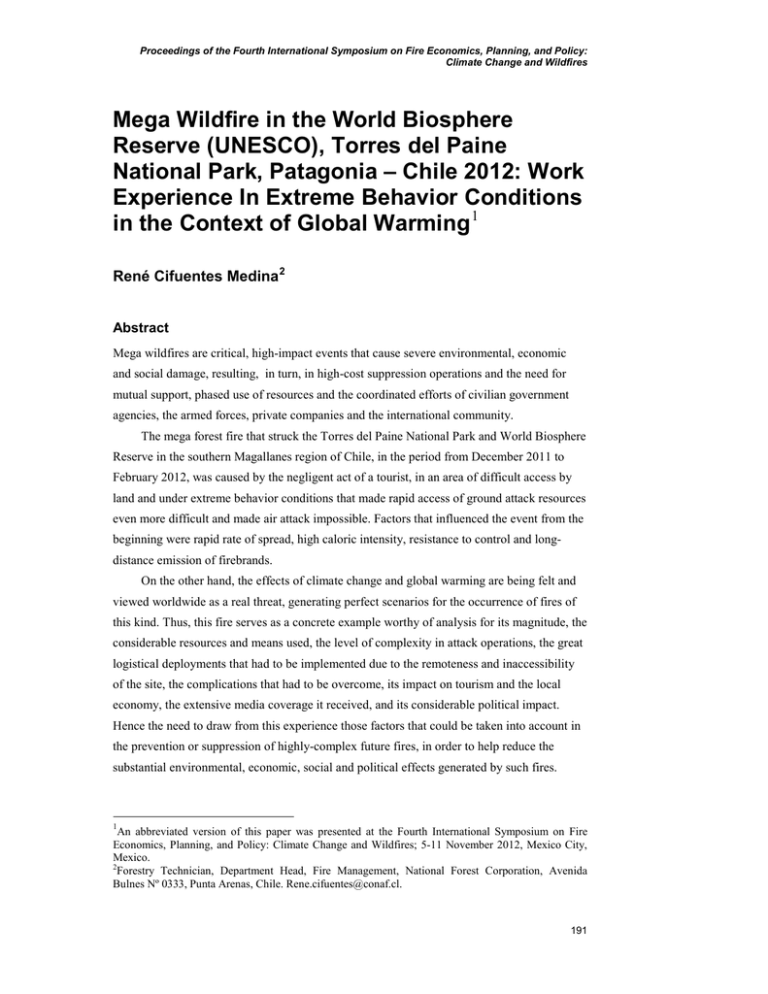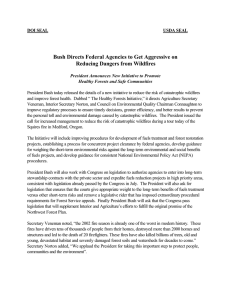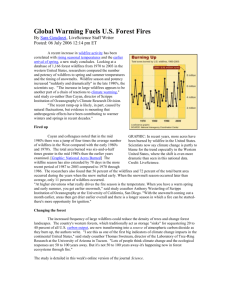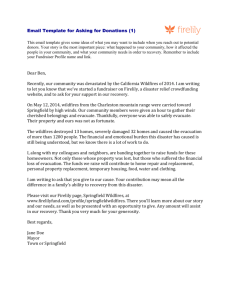Document 11230941
advertisement

Proceedings of the Fourth International Symposium on Fire Economics, Planning, and Policy: Climate Change and Wildfires Mega Wildfire in the World Biosphere Reserve (UNESCO), Torres del Paine National Park, Patagonia – Chile 2012: Work Experience In Extreme Behavior Conditions in the Context of Global Warming 1 René Cifuentes Medina 2 Abstract Mega wildfires are critical, high-impact events that cause severe environmental, economic and social damage, resulting, in turn, in high-cost suppression operations and the need for mutual support, phased use of resources and the coordinated efforts of civilian government agencies, the armed forces, private companies and the international community. The mega forest fire that struck the Torres del Paine National Park and World Biosphere Reserve in the southern Magallanes region of Chile, in the period from December 2011 to February 2012, was caused by the negligent act of a tourist, in an area of difficult access by land and under extreme behavior conditions that made rapid access of ground attack resources even more difficult and made air attack impossible. Factors that influenced the event from the beginning were rapid rate of spread, high caloric intensity, resistance to control and longdistance emission of firebrands. On the other hand, the effects of climate change and global warming are being felt and viewed worldwide as a real threat, generating perfect scenarios for the occurrence of fires of this kind. Thus, this fire serves as a concrete example worthy of analysis for its magnitude, the considerable resources and means used, the level of complexity in attack operations, the great logistical deployments that had to be implemented due to the remoteness and inaccessibility of the site, the complications that had to be overcome, its impact on tourism and the local economy, the extensive media coverage it received, and its considerable political impact. Hence the need to draw from this experience those factors that could be taken into account in the prevention or suppression of highly-complex future fires, in order to help reduce the substantial environmental, economic, social and political effects generated by such fires. 1 An abbreviated version of this paper was presented at the Fourth International Symposium on Fire Economics, Planning, and Policy: Climate Change and Wildfires; 5-11 November 2012, Mexico City, Mexico. 2 Forestry Technician, Department Head, Fire Management, National Forest Corporation, Avenida Bulnes Nº 0333, Punta Arenas, Chile. Rene.cifuentes@conaf.cl. 191 GENERAL TECHNICAL REPORT PSW-GTR-245 Keywords: climate change, economic impacts, mega-fires. Fire as a disruptive agent at the regional level In Chile, and around the world, forest fires are a problem that leaves no one feeling indifferent. In our country, 99% of all wildfires are anthropogenic. Statistics also show us that on average 5,500 such incidents occur each year, burning some 52,000 hectares of vegetation, with losses of approximately $57 million US, corresponding to damages assessed on the market, such as wood, facilities, livestock and other assets, in addition to the social and environmental damage. Región de Magallanes y Antártica Chilena Chile Figure 1— Location of Chile History of fire in Torres del Paine Torres del Paine Park, located in the extreme south of Chile, has such outstanding natural features that it is one of the most popular tourist attractions in the country, both for Chileans and foreigners (about 80% of all visitors are foreigners). It is one of Chile’s most emblematic protected areas, as its approximately 242,000 hectares are home to a great variety of mountain scenery, glaciers and biological richness, which led to it being recognized as a World Biosphere Reserve by UNESCO, becoming the third most visited protected area in Chile (CONAF 2012). The increasing number of visitors to the Park (approx. 160,000 visitors annually) is having a negative effect on its natural resources, as manifested through different types of effects, among which 192 Proceedings of the Fourth International Symposium on Fire Economics, Planning, and Policy: Climate Change and Wildfires the one with the greatest impact is wildfires, which affect environmental quality and jeopardize the maintenance of the natural ecosystems and their sustainability. For its physical and biological landscape, it is also a major economic asset for the region, but at the same time it also poses a major threat, as the high rate of visitors implies an increased risk of occurrence of ignition sources (Vidal and Reif 2011). Thus, in the period 1980-2012, there were 61 recorded fires, all caused by humans, affecting more than 48,000 hectares of protected area, including the great fires of 1985 and 2005 (Vidal and Reif 2011) that preceded the fire of 2011. All the above reflects the uniqueness presented by the problem of forest fires in this region, since the environmental conditions, existing vegetation and a large number of mixed variables create conditions conducive to the spread of fire and which often make it difficult to combat them. In this way a small spot fire becomes a potential mega fire with disastrous consequences. The last major fire broke out in the Park in late December 2011, continuing for about a month in its most active phase and burning a total of 17,606 hectares, of which 17,054 are within the Park’s boundaries. Of the total area burned, an estimated 59.7% was Patagonian steppe communities dominated by grasses, 28.6% was scrub or shrubland, 9.7% was native forest and the remaining 1.9% was made up of other land uses. Named the Olguin mega fire after the area where it started, it is considered one of the most devastating wildfires to have ever occurred in the history of the Park as a protected area. The magnitude of the Olguin fire stands out not only for the vast area burned, but also for the severity of the fire, which affected the vegetation and soils, and because a large section of the burned area (50%) was also consumed by the great fire that hit the park in 1985 (USNPS 2012). As a result, the destructive impact is stronger and ecosystem resilience in these sectors is lower, meaning that fire recurrence is recognized as a factor leading to progressive degradation of ecosystems in the long term (Zarin and others 2005). Development of fire suppression operations The fire spread quickly due to constant strong winds, abundant and dry organic fuel present throughout the park, area conservation efforts and a prolonged drought, resulting in a high rate of spread, high resistance to control and long-distance emission of firebrands leading to multiple spot fires. The considerable resources and means required, the level of complexity involved in firefighting operations, the presence of extreme behavior factors, the great logistical deployments required due to the remoteness and inaccessibility of the site and the numerous complications that had to be solved, necessitated implementing 193 GENERAL TECHNICAL REPORT PSW-GTR-245 a complex extended attack structure, for which all material, technical and human elements in the Magallanes region were available through the local core civil protection system, the state civil protection system, and the mobilization of firefighting resources (CONAF and private fire crews) from central regions of the country under interregional mutual aid protocols, which were still insufficient. As a result, international cooperation was required and obtained by invoking mutual aid agreements and accepting offers of assistance from friendly countries. The fire was finally extinguished on February 23, 2012, although mopping up and ash monitoring operations continued until March 2012. Organization for complex extended attack (OOAAS) Since the resources arrived on a staggered basis, the organization mounted also grew on a pace with the arrival of fire personnel, so much so that by as early as January 3, the OOAAS could be completed, in terms of what was essential for handling the emergency, all of which caused further serious logistical problems due to the long distances involved and the complexity of the supply line. Table 1—Resources used in the emergency. • • • CONAF Regional Core System ORI Plan (Integrated Regional Operation) PLANIMAG (Departmental Plan for Megafires) • • GOVERNMENT ACCEFOR (Operational Coordination Plan for Forest Emergencies) Solidarity Plan, Joint Command Southern Armed Forces INTERNATIONAL Agreement with the province of Santa Cruz, Argentina • Emergency mutual aid agreement with Argentina (ANPN) • Uruguaya National Fire Brigade • Brazilian Ministry of the Environment (IBAMA) • Departmental Fire Management Operations Plan in the Magallanes Region (CONAF) The CONAF fire management program in Magallanes covers the operation of four professional fire crews during the fire season, two of which are located in Torres del Paine National Park, one in the city of Punta Arenas, and the other in the city of Puerto Natales. 194 Proceedings of the Fourth International Symposium on Fire Economics, Planning, and Policy: Climate Change and Wildfires Integrated Regional Operations Plan (ORI Plan – CONAF) The objective of the ORI Plan is to enable the Regional Directorate of the National Forest Corporation (CONAF) to make use of all available resources, whether material or human, to support Fire Management operations during an emergency through a regional-level extended attack organization, which has technical and administrative staff at its disposal for different tasks in the regional core extended attack structure in the early hours of the fire. Departmental Plan for Megafires (PLANIMAG) CONAF The plan provides for the mobilization of fire-fighting resources on an interregional support basis for megafires. It was implemented in stages beginning on December 28, 2011 and ending in April 2012 with the demobilization of all support resources, fire crews and technical staff from different regions of central Chile. Operational Coordination Plan for Forest Emergencies (ACCEFOR Plan) of the National Emergency Management Agency’s (ONEMI) Civil Protection System The Civil Protection System’s Operational Coordination Plan for Forest Emergencies (ACCEFOR) was enacted by Supreme Decree 156 in 2002. The plan establishes the organization, procedures and overall concept of how the member agencies of the Emergency Operations Committee (armed forces, fire departments, municipalities, civil defense, public works departments, etc.) should act in the event of forest emergencies when the local response established by CONAF is exceeded. CONAF-Agrarian Council of the Province of Santa Cruz (CAP), Argentina Agreement to fight border wildfires In force since 2003, it came about as a result of the need for concerted efforts to protect Patagonian ecosystems shared by the southern provinces of Chile and Argentina, where there are no natural barriers. Argentina’s National Fire Management Plan The participation of fire crews operating under Argentina’s National Fire Management Plan resulted from the need for more trained staff and the impossibility of sending more National System fire crews to the Region because of other major fires occurring at the same in the central regions. The request was made by invoking the agreement signed between Chile and Argentina for mutual assistance with personnel and equipment in the event of a disaster. Argentina responded quickly and 195 GENERAL TECHNICAL REPORT PSW-GTR-245 appropriately by sending fire crews attached to the country’s southern National Parks. Uruguay National Fire Brigade The presence of Uruguayan fire crews was managed from the National Emergency Management Agency due to the need for specialized staff that was no longer possible to obtain from other central regions due to the existence of simultaneous fires and a red alert in those areas. Brazilian Ministry of the Environment (IBAMA) Its attendance was coordinated through the Fire Management Agency as a result of previous contacts, knowledge and training and seminar experiences involving officials of the two institutions. Table 2—Area burnt Torres del Land Use Paine N.P. Patagonian Outside the Park Total 10.272,3 247,3 10.519,6 Scrub 4738,6 304,7 5.043,3 Forests 1.702,7 - 1.702,7 Other Uses 340,7 - 340,7 TOTAL 17.054,3 552,0 17.606,3 steppe/Grassland 196 Proceedings of the Fourth International Symposium on Fire Economics, Planning, and Policy: Climate Change and Wildfires Figure 2— Torres del Paine fire perimeter Graph 1— Personnel on fireline versus area affected 1,2 891 Per. 5 17.606.3 Ha. 4,5 1 4 3,5 0,8 3 2,5 0,6 2 0,4 1,5 1 0,2 Severidad del fuego en función del impacto sobre las comunidades vegetales 0,5 0 27 -1 220 11 03 -0 120 12 10 -0 120 12 17 -0 120 12 24 -0 120 12 31 -0 120 12 07 -0 220 12 14 -0 220 12 21 -0 220 12 28 -0 220 12 06 -0 320 12 13 -0 320 12 20 -0 320 12 0 Para evaluar los impactos que este gran incendio tuvo sobre la diversidad de ecosistemas, especies vegetales y animales presentes, y para recabar información que permita proponer medidas inmediatas y recomendaciones de corto y mediano plazo 197 GENERAL TECHNICAL REPORT PSW-GTR-245 Fire severity based on the impact on plant communities To assess the effects that this megafire had on the diversity of ecosystems, plants and animals, and to gather information that would allow proposing immediate measures and short- and medium-term recommendations for the recovery of affected systems, the Ministry of the Environment (MMA) formed a technical team composed of leading professionals and researchers from different national institutions and universities to develop a diagnostic report detailing the damage and impact on plant communities as the basis for a proposed plan to restore the affected ecosystems in the short, medium and long term. In parallel, under an agreement between Chile’s National Forest Corporation and the U.S. National Park Service, a team of researchers first conducted a field campaign and then prepared a comprehensive Post-fire Response Plan (USNPS 2012). The effect of the fire on vegetation varied depending on the ecosystems and sectors affected. Figure 3 shows the degree of severity of the fire according to the Burned Area Emergency Response (BAER) report developed by the U.S. National Park Service (USNPS 2012). Figure 3— Map of the Torres del Paine fire showing the different degrees of severity during the fire. Climatic variation in Magallanes Wildfires are a widespread phenomenon in the world's terrestrial ecosystems, sensitive to global climate change that is creating more severe weather, longer 198 Proceedings of the Fourth International Symposium on Fire Economics, Planning, and Policy: Climate Change and Wildfires summer seasons and great fires, all of which has led to consensus among technical agencies such as the FAO and others as to the reality of global climate change. In the Patagonian ecosystems of Chile and Argentina, wildfires are strongly influenced by climate variability. Years of increased fire activity are usually associated with dry winters and hot summers (Veblen and others 1999). Warming of the climate system is unequivocal, as evidenced by observed global climate data (IPCC, 2007). For its part, Chile has been evaluated as a country vulnerable to climate change. Forecasts for the middle and end of the 21st century indicate a number of impacts on natural resources, because of the change in the water regime and temperature, as well as an increased incidence of extreme weather events. The region comprising Magallanes and the Chilean Antarctica is the largest and southernmost of the country. It is located from 48° 36' to 56° 30' south latitude and between 66° 25' and 75° 40' west longitude. Its proximity to 60° latitude places it close to a belt of low-pressure or sub-polar cyclone systems, which means it is continually affected by westerly winds and frequent frontal systems. With a 132,297 km2 mainland area and a 1,250,000 km2 Antarctic area, it features an impressive geography of natural grasslands and forests, fjords, gulfs, canals, islands, archipelagos, and more than seven million hectares under the National System of Protected Areas of the State (SNASPE), corresponding to natural world tourist attractions (INE 2011a), including the Torres del Paine National Park and World Biosphere Reserve. Regarding the current climate of Magallanes, based on a review of secondary information, it is possible to identify an upward temperature trend. This is consistent with global warming, calculated at 0.6 °C for the southern hemisphere in the last 130 years (IPCC 2007). This trend has also been detected in Antarctica, where it has increased by almost five times that figure, in a period of only 50 years. Regarding precipitation behavior generally, it remains stable; however, there are some significant specific trends, as seen on Evangelista Islet and Félix Bay, where there was a decrease in rainfall of 1,000 mm between 1900 and 1985 and 1,400 mm between 1915 and 1985, respectively (Endlicher and Santana 1988). According to CONAMA (2006), the evolution of precipitation in the south-central and southern part of the country since the mid 1970s has given way to a downward trend that has continued until now. While it is true that there are no conclusive data that allow asserting in exact terms the increase in the average temperature during the summer in the Magallanes region, or changes in relation to wind strength and rainfall, it can be said that Magellan's climate is determined by topographic, oceanic and atmospheric factors. These elements contribute uncertainty to our knowledge of current climate behavior and also to projections associated with global climate change, which is, undoubtedly, 199 GENERAL TECHNICAL REPORT PSW-GTR-245 increasingly producing exceptional phenomena outside of historic patterns and/or ranges, as in the case of the water deficit, variation in wind strength and consecutive days of high temperature that shape complex scenarios that favor the occurrence of forest fires and extreme behavior with high rates of spread and resistance to control. Conclusions Due to particular regional conditions which limit the effectiveness of fighting wildfires, it is clear that it is only possible to achieve an effective response through proper planning based on an assessment of the occurrence and the losses caused by wildfires, by means of a proposal outlining prevention, prognosis and suppression measures that effectively control the initiation and spread of fire, which in the case of Torres del Paine, its special topography and forest fuels provide the perfect equation for fire risk, where the threat is determined by the increasingly significant increase in visitors and the vulnerability represented by the state and the condition of its forest fuels. In this context, the linkage between human and natural systems, and their respective vulnerabilities, is particularly relevant. Adaptation involves capacity building in society to develop, evaluate and implement options as they are needed. The partnership between government, technical staff and beneficiaries is the key to achieving significant progress on climate change adaptation (Howden 2010), for which it is essential to educate society about this new scenario and improve public forest fire protection policies. Finally, to fulfill the institutional mission "to contribute to national development through the sustainable management of forest ecosystems and the mitigation of climate change effects by promoting and monitoring forest-environmental legislation, protecting vegetation resources and managing the State’s Protected Wilderness Areas, for present and future generations,” it is essential that the management and public use of this emblematic Chilean National Park is designed and developed with a science that integrates and harmonizes the goals of conservation that justified its creation, with a regulated and sustainable use of its tourist attractions, generating capacities to adapt to new scenarios imposed by climate change. References Ministerio de Agricultura – FAO. 2010. Diagnóstico de la gestión del Riesgo Agroclimático, Chile Ministerio de Medio Ambiente. 2012. Plan de restauración Ecológica del Parque Nacional Torres del Paine afectado por un incendio forestal 2011-2012, Chile 200 Proceedings of the Fourth International Symposium on Fire Economics, Planning, and Policy: Climate Change and Wildfires United States National Park Service. 2012. Burned Area Emergency Response Plan, USA. Corporación Nacional Forestal Región de Magallanes y Antártica Chilena. 2012. Documentos e informes técnicos sobre operaciones de combate del Incendio Olguín del PN Torres del Paine, Chile. 201



